ISSN ONLINE(2319-8753)PRINT(2347-6710)
ISSN ONLINE(2319-8753)PRINT(2347-6710)
Gaikwad Varsha Bhagwan, Puranik V.G
|
| Related article at Pubmed, Scholar Google |
Visit for more related articles at International Journal of Innovative Research in Science, Engineering and Technology
This system consists of air pollution sensors array, Global Positioning system (GPS) of mobile phone, single chip microcontroller, Bluetooth modem. Sensors are hardware devices that produce measurable response to a change in a physical condition of air pollution. The analog signal send by the sensors is digitized by an analog to digital converter & send to controller for further processing. CO, N, smoke and temp sensor senses the gas and communicate the data with microcontroller. Bluetooth modem is used for transmitting the data to LPC2138 to mobile. GPS modem of the mobile itself is used to send the location information. The main objective of this system is to continuously monitor the pollution level provided by the different sensor via Bluetooth modem at the control section. Hence particular plan of action should be taken to control the air pollution
Keywords |
| Air pollution, Global positioning system (GPS) of mobile phone, microcontrollers embedded systems, wireless mobile networks, sensors. |
INTRODUCTION |
| There's nothing quite like opening the door and breathing fresh air. How clean is the air for breathing now? Unless and until you're a scientist with a chemistry lab[5] at your fingertips, there's no real way of knowing.[5] The gases you're sucking up through your nose could be slowly killing you: according to the World Health Organization, two million people die from the effects of polluted air every single year.[4] Air pollution is a huge problem—and not just for people living in smog-choked cities: through such things as global warming and damage to the ozone layer, it has the potential to affect us all.[3] So what exactly causes this major environmental issue is obvious when it pours from a smokestack (chimney), but it's not always so easy to spot.[6] This smoke comes from a coal-fired power plant and its pollutants include sulphur dioxide and the "greenhouse gas" carbon dioxide.[5] Air pollution kill plants, animals or stop them from growing properly, damage some other aspect of the environment (such as making buildings crumble), or cause some other kind of nuisance (reduced visibility, perhaps, or an unpleasant odour). As with water pollution and land contamination, it's the quantity (or concentration) of a chemical in the air that makes the difference between "harmless" and "pollution." Carbon dioxide (CO2) is present in the air around us at concentration of less than 0.05 percent and breathing it usually does not harm (you breathe it out all day long); but air with an extremely high concentration of carbon dioxide (say, 5–10 percent) is toxic and could kill you in a matter of minute. |
| An environmental air pollution monitoring system measures CO, N, smoke and temp. Carbon Monoxide (CO) – Carbon Monoxide prevents the uptake of oxygen by the blood.[2] Which can lead to a significant reduction in the supply of oxygen to the heart, particularly in people suffering from heart disease, there is also increasing evidence for adverse effects of air pollution not only on the respiratory system, but also on the cardiovascular system.[4] In the system a temperature sensor in LPC 2138 is used in measuring temperature of the locality. LM35 is a pre-cession IC temperature sensor with its output proportional to the temperature (in oC). The sensor circuitry is sealed and therefore it is not subjected to oxidation and other processes [3]. With LM35, temperature can be measured more accurately than with a thermistor.[4] It also possess low self heating and does not cause more than 0.1 oC temperature rise in still air.[4] The operating temperature range is from -55°C to 150°C.[6] The output voltage varies by 10mV in response to every oC rise/fall in ambient temperature, i.e., its scale factor is 0.01V/ oC. Along with this a variable resistor output can also be set for voltage output.[3] |
 |
| Most of the above air pollution and quality monitoring systems are based on sensors that report the pollutants levels to a server via wired modem, router, or short-range wireless access points.[2] In this paper, we propose a system integrates a single-chip microcontroller, several air pollution sensors (CO, NO2, and SO2) general positioning systems (GPSs) module and Bluetooth module [1]. The integrated unit is a mobile and a wireless data acquisition unit that utilizes the wireless mobile public networks.[2] The unit can be placed on the top of any moving device such as a public transportation vehicle.[4] When the vehicle is moving microcontroller generates a frame which consist of the acquired air pollutant level from the sensors array and the physical location that is reported from the attached GPS module.[5] The pollutants frame is then uploaded and transmitted to the Pollution-Server via the public mobile network. A database server is attached to the Pollution-Server for storing the pollutants level for further usage by interested clients such as environment production agencies, regeneration authorities, tourist, vehicles and insurance companies[1].The Pollution-Server is interfaced to Google maps to display real-time pollutants levels and their locations in large metropolitan area. Effects of air pollution are hazardous to environment & human health. Due Global warming, ozone layer is depleting & heat in atmosphere is increasing thus this is the main problem we are facing hence to control this we need to develop this system.[5] |
II. HARDWARE ARCHITECTURE |
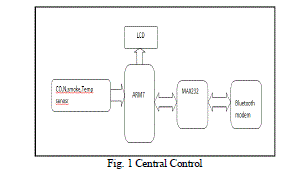 |
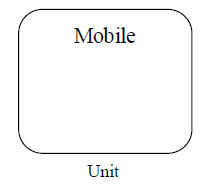 |
| A. Wireless sensor node A wireless sensor network (WSN) is an infrastructure consisting of computing,sensing and communication elements which allows the administrator to monitor & control of the specified parameters in the network. Typical application of WSN includes data collection, monitoring, surveillance & medical telemedicine. It is also used in irrigation system, Greenhouses for monitoring & controlling parameters like water flow, temp, humidity, moisture, etc[1]. B. Sensors Sensors are hardware devices that produce measurable response to a change in a physical condition of air pollution. The analog signal send by the sensors is digitized by an analog to digital converter & send to controller for further processing. There are different types of sensors from which we can select the suitable & appropriate sensor depending on the application.[2] Sensor 1 (CO sensor):- The CO sensor senses the gas and communicates the data with microcontroller. Sensor 2 (N sensor):- The Nitrogen sensors sense the gas and communicate the data with microcontroller. Sensor 3 (smoke sensor):- The smoke sensor senses the gas and communicates the data with microcontroller. Sensor 4 (temp sensor):- The temp sensor senses the temperature and communicates the data with microcontroller. |
| C. Bluetooth Module HC-06 In the proposed system, we are using Bluetooth modem for transmitting the data to lpc2138 to mobile. These small size Bluetooth TTL transceiver modules are designed for serial communication (SPP - serial port profile).[7] It allows target device to send or receive TTL data via Bluetooth technology without connecting a serial cable to your computer.[6]The modules with the HC-06 firmware are the modules which are factory set to be Master or Slave modules.[7] Master and slave mode cannot be switched from the factory setting.[8] HC-06 is a commercial grade product.[6] |
| ïÃâ÷ Bluetooth® Technology v2.0 + EDR ïÃâ÷ TTL data transparent transfer is between a host Bluetooth device ïÃâ÷ It is compatible with all Bluetooth adapters that support SPP ïÃâ÷ Coverage up to 30 ft / 10 m ïÃâ÷ Built in antenna ïÃâ÷ Power input: +3.3VDC (bluetooth module) ïÃâ÷ It can set the module control parameters and control commands via AT commands [6] ïÃâ÷ The maximum serial baud rate is 1382400 bps, support for hardware flow control transfer ïÃâ÷ Provide seven input and output ports ïÃâ÷ Connection/non-connection status indicators[5] |
| D. Microcontroller unit Microcontroller like ARM (LPC2138) processes data, performs tasks and control the functionality with other components in the sensor node. Arm Processor:-The ARM7 based microcontrollers run on load-store RISC architecture with 32-bit registers and fixed op-code length. The architecture provides a linear 4GB memory ad-dress space. The ARM7 core is easy to use, cost-effective, and support modern object-oriented programming techniques. E. Global Positioning System GPS receivers are used for navigating, positioning, surveying, locating and determining the time and are employed both by private individuals and companies. During the development of the GPS system: (a) It has to provide users with the capability of determining time, speed and position whether in motion or at rest.[3] (b) It should have a continuous, global, 3 dimensional positioning capabilities with a high degree of accuracy, irrespective of the weather.[3] Global Positioning System is essential standard used for navigation, tracking and location aware data logging. Board can be interfaced with a microcontroller through UART. Data such as latitude, longitude of the area where vehicle located are received. Board features connector compatible with antennas. It can operate on 3.3V power supply only.[3] F. LCD Display Liquid Crystal Displays are the best man and machine interface giving impressive visual information, displaying Icons, Symbols, Numerical, Alphabets and Characters. We have used ODM’s 16x2 LCD Digital Display. This system consists of Mobile Data-Acquisition Unit (Mobile-DAQ) and fixed Internet Enabled Pollution monitoring Server(Pollution server).Mobile-DAQ consists of a 32-bit single- chip microcontroller integrated with a sensor array using analog ports. The Mobile-DAQ is connected to a Bluetooth module and mobile phone using RS-232 interface.[4] |
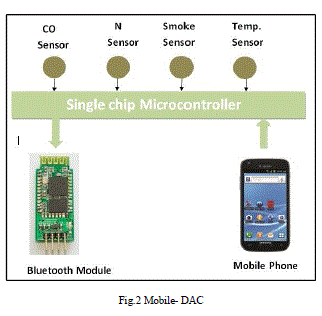 |
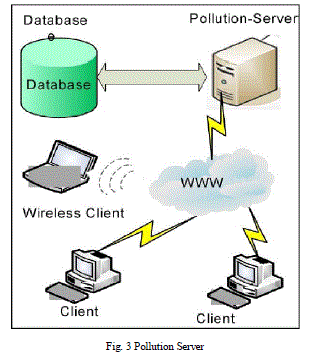 |
| Pollution Server It connects to a database management system via (LAN) Local area network. The Pollution server connects to the Bluetooth module via TCP/IP through internet and public mobile network. Clients like travel agencies, tourist companies, municipality, insurance companies, environmental protection agencies connect to the Pollution- server via Internet and check the real time air pollutants level using a normal browser on a standard PC or a mobile phone.[1] |
III. SOFTWARE ARCHITECTURE |
| A mobile web server is software similar to Apache HTTP Server, or Apache Jetty Server, which provides a mobile device, such as tablet,smart phone.[4] The capability to host web sites, web applications, and web services.[6] Hosting web services on a mobile server will bring convenience, potential, flexibility to the consumers. This will revolutionize the way we share data,communicate and gather information.[5] Mobile web servers face unlimited possibilities in the areas of enterprise mobile data access and sharing for lucrative markets such as the music,military and health care, are some of the examples. Engineering mobile devices around the world as mobile web servers would change the internet landscape.[4] It would fundamentally alter the way we access web services such as maps with geo-location documents, medical records,information and news.[5] Mass transit systems could use a mobile server hosting a geo-location service providing scheduling, real-time location and route information to the commuters. |
| The primary goals were to bring a full-fledged web server to Smartphone and to make a web-server running on a mobile phone accessible from the Internet using any web browser.[6] Providing access to a mobile phone from the Internet is not straightforward, as operators usually employ firewalls that prevent access from the Internet to phones inside that firewall. By implementing a custom gateway we could circumvent that limitation and we are now able to provide a web-server on a mobile phone with a global URL than can be accessed from any of the browser.[6] In a way, the mobile phone has now finally become a full member of the Internet. |
| The components that enable this application are the following: ïÃâ÷ An android server which will allow users to host web-sites. ïÃâ÷ An android application which will be responsible for HTTP protocol ïÃâ÷ Communication ïÃâ÷ Most of the communication to the platform occurs over the TCP port connected to the Android Device Communications Server. Communication commands include information such as ports used for streaming the video, user log in information, session identification, play and termination commands. Sign up and forgot password dialogs take advantage of the functions already implemented on the server side web page by using the java built in HTTP client to fetch web pages using GET by including required information in the GET URI. |
IV. IMPLEMENTATION |
| Algorithm ïÃâ÷ Start ïÃâ÷ Initialize all the devices ïÃâ÷ Read the inputs from sensors ïÃâ÷ Display it on LCD ïÃâ÷ Send it to the android phone ïÃâ÷ All the values can be seen from anywhere as it displays on web page. ïÃâ÷ Go to step 3. Software used ïÃâ÷ Keil Micro Vision: ïÃâ÷ Regarding the compiler and IDE used we have used Keil Micro Vision 3 which is provided by KEIL for development on ARM controller. ïÃâ÷ It supports the USB boot loader enabled controller. It supports the on-chip debugging and programming tool. ïÃâ÷ It currently supports all ARM family devices. It even facilitates the download of program to the ARM ISP board. |
| System Specification: Hardware: Microcontroller (LPC 213x) Gas sensors Bluetooth module Software: Keil micro vision 4: for LPC2138 Languages used: embeddec c, JAVA for the mobile |
V. RESULT |
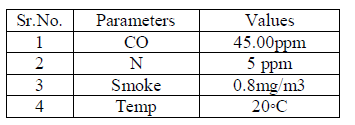 |
VI. CONCLUSION |
| System utilizes city buses to collect pollutant gases such as CO, N, smoke and temp. The pollution data from various places sense by sensor arrays is transmitted to a control central unit that make this data available on the Internet through a Google Maps interface by using Bluetooth module. |
ACKNOWLEDGMENT |
| My sincere thanks to my honorable guide Prof. V.G. Puranik and others who have contributed towards the preparation of the paper. |
References |
|